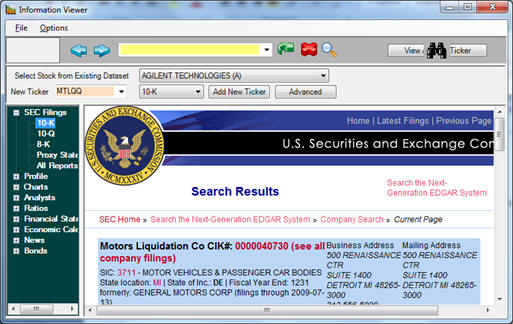10.5 Example 2:
General Motors (GM)
At
the time of the writing of this chapter, GM is not longer under the
ticker GM, instead it is trading as “Motors Liquidation Ordinary
Shares” and ticker MTLQQ. On Dec 31
2008, it traded at $3.20 per share.
To get
information about GM, in the information system, click “View Another
Ticker:”

In the new window that appears, type in MTLQQ as the ticker, select filing tyoe 10-K, and add the ticker. GM’s 10-K will appear:

The “Interactive
Data” link is not available, so click on the 10-K document, scroll
down to the table of contents and click on “Consolidated Balance
Sheets”:

This leads you
to the statement of assets and liabilities, and when we did this,
the assets at the end of 2008 were 91.047m:

Scroll down
further to see the liabilities at the end of 2008:

You can see the
breakdown of liabilities, the total being 176.387m.
The shares
outstanding were 610 (all the amounts are in millions).
So we have the assets and the strike price of the option on a
per-share basis: A = 149.26, F=285.16.
What should we
use as the maturity of the option?
Technically, this is the first date at which a company fails
to make a debt payment; that failure triggers default, and under the
laws of many countries, the bond holders are then among the first in
line to either receive the assets of the company or, as commonly
happens, to agree to a restructuring.
But at that point, the stock is worthless. Let us calculate
what the value of GM would be if all the debt was due in 6 months.
The 6 month
Treasury bill yield at the time was 0.34%.
So that leaves
the last input, asset volatility.
To start with, let’s try different volatility numbers and see
how much difference they make.
We did the exercise repeatedly in Valuation Tutor to come up
with the following:
|
Asset Volatility |
Calculated Value |
Market Price |
|
0.4 |
0.1941 |
3.20 |
|
0.5 |
0.8761 |
3.20 |
|
0.6 |
2.2380 |
3.20 |
|
0.6512 |
3.2000 |
3.20 |
|
0.7 |
4.2700 |
3.20 |
You can see that
with an asset volatility of 0.6512, the calculated value matches the
market price:

So it is
plausible that the stock could trade for $3.20.
Of course, we had to guess at the asset volatility to make it
come out right, i.e. ask: what asset volatility makes the calculated
value equal to the market price?
So you might be asking how useful this is.
It turns out you
don’t have to guess. You
can calculate the asset volatility in another way, from the
volatility of the stock return.
This volatility can be calculated from historical stock
returns or as the implied volatility from options on the stock.
